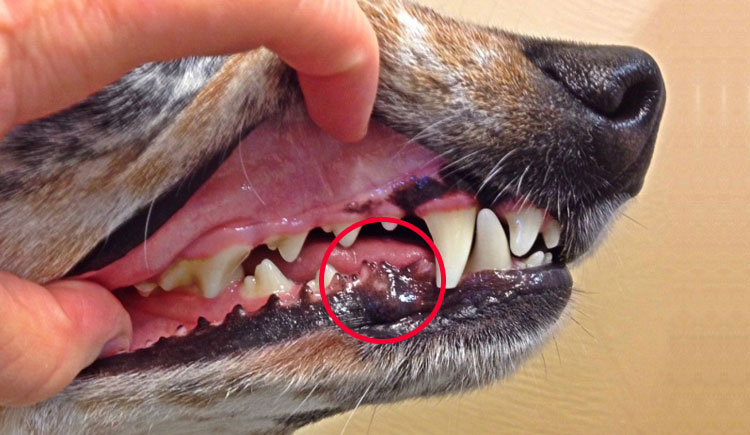melanoma is sometimes called malignant melanoma.
Primary malignant melanoma of the mouth is an extremely rare tumor arising from the uncontrolled growth of melanocytes found in the basal layer of the oral mucous membrane. Patients with oral malignant melanoma often recall having an existing oral pigmentation months to years before diagnosis, and the condition may even have elicited prior comment from examining. Where are melanomas frequently found in dogs? Management of melanoma is evolving. At present, the clinicopathological classification of oral melanoma is not yet clearly outlined;

oral melanoma is the most common malignant oral tumor in dogs.
They tend to develop on highly pigmented parts of the skin. Aggressive and also have a high likelihood (80%) of metastasis (spread. This page is currently under development. Ocular and oral melanomas tend to be more malignant than skin melanomas. oral malignant melanoma (omm) is a rare and very aggressive neoplasm of melanocytic origin with a high potential for metastasis, most commonly to the lungs and brain. She covers where they metastasize or spread to, what diagnostic tests you will want to do, the prognosis. 1 bergman pj, et al. Any size with distant metastatic disease. She covers where they meta. oral melanoma is the most common oral tumor in dogs and can affect the lips, gingiva, and the tongue. Please check back later for information about malignant melanoma of the face. The most common oral tumors in dogs include: Specific metastatic sites include the.
It is a rare aggressive neoplasm usually found on the hard palate and gingiva. melanoma, squamous cell carcinoma, sarcomas, and ameloblastomas. Co., inc., kenilworth, nj, usa is a global healthcare leader working to help the world be well. What is melanoma • melanoma is a very serious form of skin cancer. This page lists cancer drugs approved by the food and drug administration (fda) for melanoma.

Squamous cell carcinomas are by far the most common malignant oral neoplasms in cats;
They tend to develop on highly pigmented parts of the skin. oral malignant melanoma (omm) is the most common oral tumor in dogs, while it is an uncommon oral tumor in cats. The tumors tend to metastasize or locally invade tissue more readily than other malignant tumors in the oral region. This page is currently under development. oral malignant melanoma (omm) is considered the third most common oral malignant neoplasm in cats, but its variable morphology and frequent lack of melanin pigment make it a diagnostic challenge. Hicks and flaitz 8 in a review of oral malignant melanoma showed a male predilection and an age range of 22 to 83 years, with a mean age of 56 years. oral melanoma is the most common malignant oral tumor in dogs. The association between lymph node size and metastasis was determined. For up to date recommendations, refer to australian cancer council clinical practice guidelines for the diagnosis and management of melanoma. (received for publication february 1996. This tumor is both locally aggressive and rapidly metastatic (high ability to spread to other body sites). She covers where they meta. Management of melanoma is evolving.
oral melanomas are the most common malignant oral tumor in dogs. oral melanoma is the most common malignant oral tumor in dogs. The skin is the body's largest organ.it protects against heat, sunlight, injury, and infection.skin also helps control body temperature and stores water, fat, and vitamin d.the skin has several layers, but the two main layers are the epidermis (upper or outer layer) and the dermis (lower. Squamous cell carcinomas are by far the most common malignant oral neoplasms in cats; Report of an unusual case i.

Co., inc., kenilworth, nj, usa is a global healthcare leader working to help the world be well.
malignant melanoma is a cancer that arises from cells that produce the black pigment melanin. Tumor size and metastases are related to the prognosis of the disease. Aggressive and also have a high likelihood (80%) of metastasis (spread. Specific metastatic sites include the. 3,4 omm and other mucosal malignant melanomas are considered more aggressive than cutaneous malignant melanomas with high rates of recurrence and death. The median survival of dogs with stage iv omm has been. Among canine malignant melanoma, oral malignant melanoma (omm) is characterized by high invasiveness and metastatic propensity 13,14. melanoma is a disease in which malignant (cancer) cells form in melanocytes (cells that color the skin). At present, the clinicopathological classification of oral melanoma is not yet clearly outlined; This malignancy commonly affects male subjects and is more frequently seen at the level of the hard palate and gingiva. She covers where they meta. oral malignant melanoma in a dog. It is a rare aggressive neoplasm usually found on the hard palate and gingiva.
View Malignant Melanoma Oral PNG. Clinical stages of canine oral melanoma 1. Proliferation and accounts for only 0.5% of all oral malignancies. oral melanoma is the most common oral tumor in dogs and can affect the lips, gingiva, and the tongue. These tumors are both locally invasive and have a high tendency to metastasize to other organs. Management of melanoma is evolving.
Bone morphogenetic protein (bmp) is abundantly expressed in bone malignant melanoma. The median survival of dogs with stage iv omm has been.






